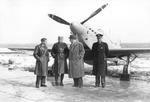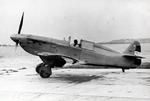IK-3
| Country | Yugoslavia |
| Manufacturer | Rogozarski A.D., Belgrade |
| Primary Role | Fighter |
Contributor: Alan Chanter
ww2dbaseIn 1936, it was becoming obvious that the heyday of the biplane and high-wing monoplane configurations for fighter aircraft was passing, and all the major aircraft-manufacturing nations were turning their attention to designing low-wing high-speed monoplanes with fully retractable undercarriages. During 1938, engineers Ljubomir Ilic and Kosta Sivcev, who had previously designed the Ikarus IK-1and IK-2 gull-wing monoplane fighters, were joined by Slobodan Zrnic to initiate work for Rogozarski A.D at Belgrade, Yugoslavia on a private venture for a new monoplane fighter for the Yugoslavian Air Force. The resultant design incorporated cantilever low-wings, an enclosed cockpit and fully-retractable landing gear. This aircraft was initially designated IKZ or IK-Z, but the similarity between the Cyrillic "Z" and the Arabic "3" led to confusion and, as a result of common usage, the fighter became known widely as the IK-3. All preparatory work was undertaken in strict secrecy, with a model being successfully tested in the Eiffel wind tunnel in Paris, France. The design was then submitted to the Yugoslav Air Ministry in Mar 1937, who agreed to issue a contract for a single prototype to the built for evaluation. The completed prototype, with Kapetan (English: Captain) M. Rjelanovic at the controls, would make its maiden flight towards the end of May 1938.
ww2dbaseThe prototype, powered by a Hispano-Suiza 12Y-29 engine, rated at 890 horsepower for take-off and 920 horsepower at 3,600 metres, had a fuselage of steel-tube structure with plywood stringers and metal skinning forward and fabric aft. The wings were of wooden construction with plywood skinning, and fitted with metal-framed, fabric covered ailerons and dural flaps. Initial flight trials were extremely successful, requiring only a few minor modifications to the Messier design undercarriage and engine installation. Five other pilots flight-tested the IK-3 before the machine was destroyed in a fatal crash on 19 Jan 1939 when it took-off from Zemun airfield, to perform a series of aerobatics. When the starboard wing failed during a terminal velocity dive the pilot, Kapetan Pokorni, was unable to recover control. A subsequent investigation into the accident would completely exonerated the aircraft, and the Air Ministry, now sufficiently impressed by the test results, duly signed an order for an initial batch of twelve production aircraft.
ww2dbaseThe production IK-3 aircraft would differ in few respects from the prototype. Some modifications were made to the wing structure and revised undercarriage fairings were installed. Additional frames were added to the sliding cockpit canopy and a bullet-proof windscreen was also fitted. The production IK-3 would carry an armament of a single 20-millimeter Swiss Oerlikon FF with 60 rounds (replacing the French 20-millimeter HS 404 cannon in the prototype), located between the engine’s cylinder banks, and two 7.92-millimeter FN-Browning machine guns in the upper part of the forward fuselage. The HS 12Y29 engine was replaced too with an Avia–built version of the Hispano-Suiza 12Ycrs rated at 860 horsepower at 4,000 metres.
ww2dbaseThe first six Production IK-3 aircraft were delivered in late Mar 1940 to the 52nd Fighter Squadron for evaluation. Pilots quickly expressed a preference for the new fighter over their other machines; reporting that it was more manoeuvrable than their Messerschmitt Bf-109E-3 aircraft and easily able to turn inside a Hawker Hurricane I fighter. The controls, they noted, were exceptionally well co-ordinated and maintenance proved simple – a factor of great importance in view of the poor servicing equipment on most Yugoslav airfields.
ww2dbaseThe remaining six aircraft from the initial order were completed by Jul 1939 and all twelve machines were subsequently allocated to the 161st Fighter Squadron (Kapetan Savo Poljanec) and the 162nd Fighter Squadron (Kapetan Todor Gogi?) of the 51 Grupa based at Zemun (six aircraft to each). When they first entered service, the IK-3 fighter were found to suffer from minor equipment and instrument faults, which, largely due to deficiencies in the Yugoslav aeronautical industry, had resulted in a mixture of foreign and Yugoslav-made instruments having been fitted in the aircraft. These IK-3 fighters when tested against Yugoslav Messerschmitt Bf 109E fighters in mock dogfights soon revealed that the IK-3 aircraft had several advantages over the German fighter; in particular, the IK-3 aircraft was found to be far more manoeuvrable in level flight, enabling it to quickly get behind a pursuing Bf 109E fighter by making tight horizontal turns. In its first year of service, one IK-3 fighter was lost when squadron commander Kapetan Anton Ercigoj, while making a mock attack on a Potez 25 over the confluence of the Sava and Danube rivers attempted to perform a loop but fell into a spin at low altitude and crashed into the river.
ww2dbasePlans were now made by Rogozarski to accelerate production of the IK-3 design despite the fact that, together with the Zmaj concern, the company was heavily involved in the licence manufacture of one hundred Hurricane fighters (Rogozarski's part in the Hurricane programme was forty machines) and, with the completion of this work, the Belgrade factory would begin work on building another twenty-five IK-3 fighters for the Yugoslav Air Force. Negotiations were also being conducted with the Turkish government who were considering the licence manufacture of the IK-3 design. Later still, the Yugoslav Minister of War approved the acquisition of a further 48 IK-3 aircraft to be delivered in 1941–42 but these would never become available following the German occupation.
ww2dbaseIn the meantime, the design team were also working on an improved versions of the IK-3. It had originally been planned to power later IK-3 aircraft with the new 1,100 horsepower Hispano-Suiza 12Y-51 engine, but the German occupation of France in 1940 had frustrated this plan, and it therefore became necessary to consider either a British or German engine. The Air Ministry favoured the Daimler-Benz DB601A and, as one part of the development programme, one engine was experimentally installed in a Hurricane airframe. The conversion was extremely successful, and the modified aircraft displayed better take-off performance and climb rate than either the standard Hurricane fighter or the Bf 109E-3 fighter and was only slightly slower than the latter. At the same time, a Rolls–Royce Merlin III engine was installed in one of the IK-3 airframes, but this conversion had only just been completed at the time of the German invasion, and when enemy forces neared Belgrade it was destroyed by the factory workers, together with four other IK-3s undergoing overhaul or modifications.
ww2dbaseShortly before the Axis invasion of Yugoslavia on 6 Apr 1941, the 51st Fighter Group was placed under the 6th Fighter Regiment, with responsibility for the defence of Belgrade. The group was further reinforced the day before the invasion began, with the 102nd Fighter Squadron equipped with ten Bf 109E aircraft. However, when the invasion began the two IK-3 squadrons had only three serviceable aircraft each. The attack commenced with a wave of 234 German dive bombers and medium bombers attacking Belgrade. Escorted by 120 fighters, the bombers reached Belgrade at 0700 hours where they were intercepted by the 51st Fighter Group, minus one IK-3 aircraft from the 161st Fighter Squadron that had developed engine trouble after take-off and was unable to engage. The other five IK-3 fighters engaged the enemy bomber but, in turn, they were almost immediately attacked by the escorting Bf 109 fighters of JG77. The Yugoslav pilots claimed the destruction of five German aircraft, for the loss of one Yugoslav machine brought down. After this first encounter, only three IK-3 aircraft remained serviceable, but these would put up a valiant resistance against the Luftwaffe, scoring at least 10 or 11 kills before the survivors were burned on Veliki Radinci airstrip during the night of 11-12 Apr 1941 to prevent their seizure by the victorious Germans.
ww2dbaseIt is of interest to note that at the time German forces entered Belgrade, Rogozarski were also working on a twin-engine fighter, the IK-5, projected in two versions: a single-seat interceptor and a two-seat long-range destroyer with exceptionally heavy nose-mounted armament. Wind tunnel tests with models of the IK-5 had been completed, and construction of a prototype commenced but no further work would follow the Axis occupation.
ww2dbaseSources:
William Green: War Planes of the Second World War-Fighters, Volume 4 (Macdonald Press, 1961)
William Green & Gordon Swinborough: The Complete Book of Fighters (Salamander Books, 1994)
Chris Chant: Aircraft of World War II (Dempsey Parr, 1999)
Last Major Revision: Aug 2019
IK-3 Timeline
| 19 Jan 1939 | The prototype of the IK-3 fighter crashed near Zemun airfield in Yugoslavia, killing the pilot Captain Pokorni. |
| 12 Apr 1941 | Before dawn, all three surviving IK-3 fighters in the Yugoslav Air Force were burned by their own crews to prevent German seizure. |
SPECIFICATIONS
IK-3
| Machinery | One Avia 12Ycrs V-12 liquid-cooled petrol engine rated at 920hp |
| Armament | 1x20mm Oerlikon FF cannon, 2x7.92mm FN-Browning machine guns |
| Crew | 1 |
| Span | 10.30 m |
| Length | 8.00 m |
| Height | 3.25 m |
| Wing Area | 16.50 m² |
| Weight, Empty | 2,068 kg |
| Weight, Maximum | 2,630 kg |
| Speed, Maximum | 848 km/h |
| Service Ceiling | 9,460 m |
| Range, Maximum | 785 km |
Photographs
 |  |  |  |
Please consider supporting us on Patreon. Even $1 per month will go a long way! Thank you. Please help us spread the word: Stay updated with WW2DB: |

- » US State Lawmaker John Winter Caught Using Racial Slur "Jap" and Apologized (11 Jun 2025)
- » Köln/Cologne Evacuated After Discovery of WW2 Bombs (4 Jun 2025)
- » US Women's Army Corps "Six Triple Eight" Awarded with Congressional Gold Medal (30 Apr 2025)
- » Race, Holocaust, and African-American WW2 Histories Removed from the US Naval Academy Library (7 Apr 2025)
- » US Government Plans to Purge WW2 Information (17 Mar 2025)
- » See all news
- » 1,177 biographies
- » 337 events
- » 44,933 timeline entries
- » 1,245 ships
- » 350 aircraft models
- » 207 vehicle models
- » 376 weapon models
- » 123 historical documents
- » 261 facilities
- » 470 book reviews
- » 28,473 photos
- » 365 maps
Winston Churchill
Please consider supporting us on Patreon. Even $1 a month will go a long way. Thank you!
Or, please support us by purchasing some WW2DB merchandise at TeeSpring, Thank you!